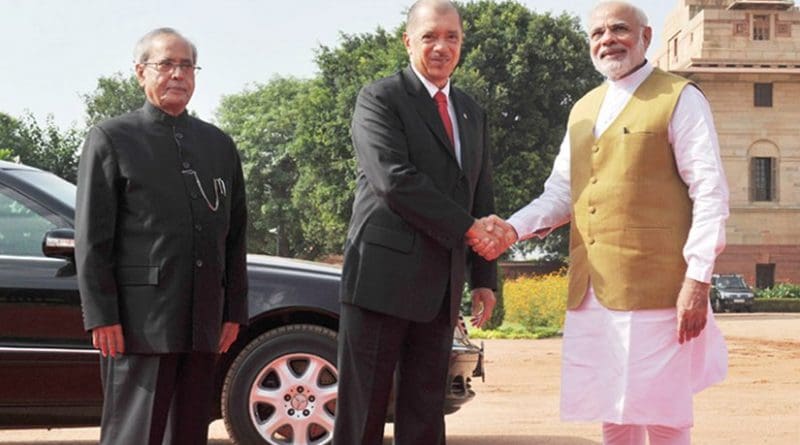India’s Engagement With Mozambique And Seychelles – OpEd
In the month of August, the presidents of Mozambique and Seychelles visited India. The President of Mozambique was in India between 4th to 8th August whereas President of Seychelles came in the last week (25th to 27th) of August. Both these visits were significant for India’s engagement with the Indian Ocean region but went largely unnoticed in Indian media.
Earlier this year, Indian Prime Minister Modi visited Seychelles as part of his tour of Indian Ocean states which included Sri Lanka, Mauritius and Seychelles. Visit of Modi was reciprocated by Seychelles’ President. In case of Mozambique, Modi has not visited it (or any other African nation) so far but India and Mozambique enjoy cordial ties. This time India was Mozambique President’s first destination in Asia, a significant fact in the context of increasing Chinese presence in Africa. He had visited India before when he was Defense minister in 2011.
Although India’s economic and developmental profile is rising in the region, larger political and strategic reasons take precedence in relations with these states. Mozambique and Seychelles are strategically located in the South-West Indian Ocean near the Cape of Good Hope. Mozambique is immensely resource rich and location of Seychelles makes it India’s maritime neighbor along with Maldives, Thailand and Indonesia among others. Mozambique and Seychelles share similar developmental challenges as does India. They are also concerned about issues of maritime piracy, coastal security and adverse effects of climate change.
India enjoys historical ties with these states going back to centuries. Mozambique and India (Goa) are connected by common colonial past of Portuguese rule whereas Seychelles and India were parts of British Empire. Non Aligned Movement, of which India was an important member, had supported decolonization of Portuguese Africa and Mozambique’s independence in early 1970’s. Mozambique achieved its independence in 1975 and Seychelles in 1976. This year marks 40th anniversary of Mozambique’s independence and also establishment of Indo-Mozambique ties. Since their independence, India has remained engaged with both these states.
In mid-1980’s, India had (secretly) helped existing regimes in Mozambique and in Seychelles to thwart coups and maintain stability by deploying its naval and air assets, in and around them. Active role played by India in this part of the world then reinforced India’s role as a net security provider in the region. This image of India as a net security provider in Indian Ocean Region has assumed greater significance over the years with increased capabilities of Indian navy. India’s engagement with these states in matters of defense and security has continued with gifting of naval and air assets for surveillance and reconnaissance, training their defense personnel and conducting anti-piracy operations. Several vessels from Indian navy have paid regular visits to these states. The Indian Navy had carried out hydrographic surveys and deployed its ships to secure Exclusive Economic Zone (EEZ) on the request of Seychelles government as well. Even in this recently concluded Presidential visit, India agreed to provide one more Dornier maritime aircraft (for surveillance) to Seychelles. (It had gifted two in March.)
Both these states are members of the United Nations (UN) and support India’s bid for permanent membership of UN Security Council. They are also integral members of Indian Ocean Rim Association, the only regional organization in Indian Ocean region. Geographically, Mozambique and Seychelles are parts of African continent and hence are invited along with 52 other African states for India-Africa summit, third edition of which will take place in October, 2015 in India. In fact, out of total Indian investments in the African continent, 25% of it was invested in Mozambique. Most of the Indian investments are in the fields of coal and hydrocarbons. Mozambique, being resource rich state, occupies important position in India’s quest for energy security.
In the recently concluded visits, agreements were signed to co-operate in fields of agriculture, connectivity, solar energy, development and defense. These agreements are expected to take the relationships further ahead. One more interesting facet of these countries is the significant number of Indians living there. About 10% of Seychelles’ population is of Indian origin whereas in Mozambique, Persons of Indian Origin number about 20,000. India’s current Prime Minister Modi has stressed on engaging Indian diaspora abroad. In this endeavor, Mozambique and Seychelles could also be factored in as vital states.
In the last few years, Indian Ocean has occupied increasing importance and space in world politics. But in the emerging literature on Indian Ocean region more focus is given to South-East, West and South Asia. Indian Ocean Maritime Africa (IOMA) is neglected in these debates. For a regional and maritime power like India (which is intimately engaged in the politics of the region), IOMA states assume greater significance in the face of rising challenges like maritime piracy and growing Chinese footprint in the region. Only geostrategic advantages of location will not be sufficient for India to maintain its preeminence in the region. And for that purpose, these recently concluded visits are significant for India’s emerging policy towards Indian Ocean.
*Sankalp Gurjar is a PhD candidate at South Asian University (A University established by SAARC nations), New Delhi. His research areas include India’s Foreign and Defense policies, Great Power politics and Indian Ocean Region.

